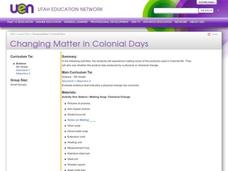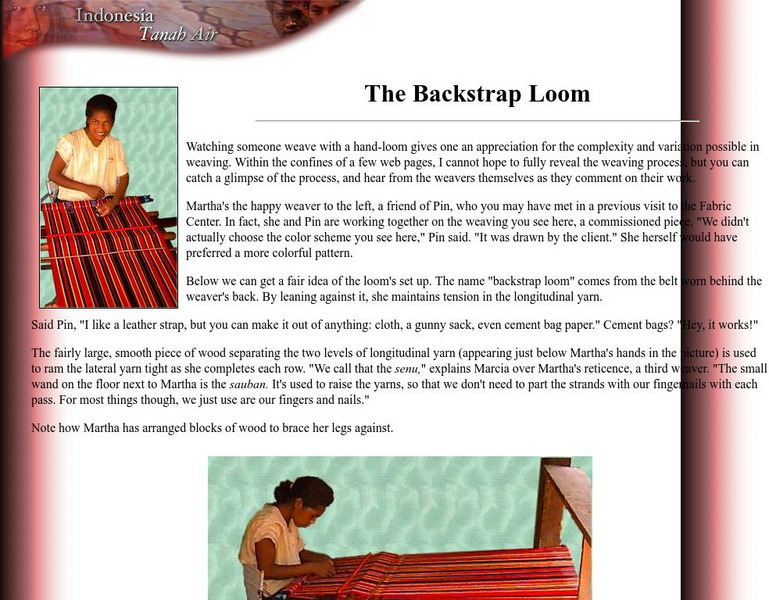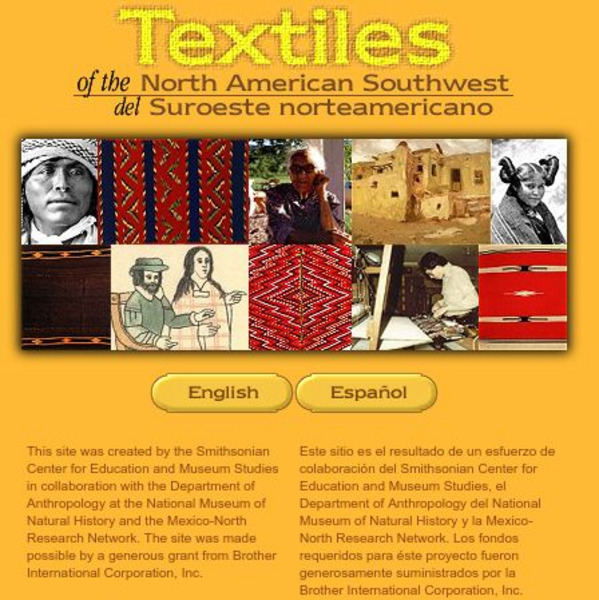Curated OER
Show Your Colors and Make Freedom Bracelets
Learners understand the meaning of a freedom bracelet. In this terrorism lesson, students create freedom bracelets as a statement against terrorism. Learners weave this creative project in red, white and blue to show support of their...
Curated OER
From Sheep to Rug
Ever wonder where wool comes from? How it is used to make a woven rug? Introduce the Native American craft of rug making to your preschool or kindergarten class with a discussion. Learners examine and discuss images of a Native American...
Curated OER
Meet Hannah the Weaver
Students analyze primary and secondary sources to explore slavery and emancipation, and write letter or diary entry from point of view of slave Hannah Harris or plantation owner Robert Carter. Students then dramatize their creative...
Curated OER
Chalkboard Challenge: The Beginning of Human Society
After studying Ancient Civilizations, learners could use this jeopardy-like game as a review. Having questions relating to the Neolithic, Paleolithic Era, and more, this presentation would be a great whole class or center activity.
Curated OER
Exploring Meaning In Native American Art
Native American artwork includes symbolism that will inspire students' own work.
Curated OER
Battering Through the Seasons
Students define bartering and barter to investigate supply and demand. In this bartering lesson plan, students read A New Coat for Anna and recall how they exchanged merchandise in the story. Students complete a sequential graphic...
Curated OER
Native American Interdisciplinary Educational Unit
Pupils research various Native American stories and legends. They participate in reader's theater, write original legends, cook Native American foods, construct dioramas and view Native American art and artifacts.
Curated OER
The Emperor's New Clothes
In this comprehension worksheet, students answer short answer and discussion questions for the story The Emperor's New Clothes. Students complete 14 questions.
Curated OER
Colonial Life
Fifth graders explore American colonial life. In this interdisciplinary history and science lesson, 5th graders participate in several hands-on activities that require them to make colonial products that involve physical or chemical...
John F. Kennedy Center
The Kennedy Center: Lesson: Navajo Weaving
Intergrating dance into your social studies lesson on the Navajo culture will give your students a glimpse into another way of life. They will use their knowledge of loom weaving, Native Americans, and creative dance to express these...
Other
Dick Blick Art Materials: Paper Weaving [Pdf]
This lesson plan gives young scholars a chance to try weaving with paper and features illustrated instructions, extension ideas, and objectives.
Other
African Craft: Small Loom Weaving
Directions on how to make a simple loom from a wooden board and dowel rods. This style is representative to a traditional African loom. Try a new way of weaving in your classroom.
Marilyn J. Brackney
Imagination Factory: Soda Straw Weaving
Using plastic straws and yarn, young children can weave a bracelet or bookmark. Website includes detailed instruction on how to weave using soda straws and images showing the various steps.
Other
Multicultural Literature for Children: Abuela's Weave
This lesson plan is perfect in an ESL classroom. "Abuela's Weave" is the story of a young girl from Guatemala and the beautiful tapestry she creates. Includes prereading questions, vocabulary, and activities to integrate into other...
Other
Alien Travel Guide: History of Weaving
This site from the Alien Travel Guide contains an outline to information on the history of weaving. The outline is in link form for easy navigation and it contains wonderful basic information.
Other
Manalagi Group: Weaving in Indonesia
This site from Manalagi Inc. contains information on the weaving in Indonesia with focus on the backstrap loom. Pictures are provided and the text is somewhat in-depth, making this a great site to check out on the subject.
Other
Native Web: Miguel Andrango, Maestro Del Telar
Indigenous artisan, Miguel Andrango, is described as the "master of the loom." Miguel, and others like him in the Andean highlands of northern Ecuador create traditional weavings with the dying method of what is called a backstrap loom....
Marilyn J. Brackney
Imagination Factory: Show Your Colors and Make Freedom Bracelets
Providing a patriotic-themed art activity,this website shows children how to weave "a bracelet using a simple loom." Included are directions for making simple and more-complex bracelets.
EL Education
El Education: One Weave at a Time
Students create an instructional guide to weaving that includes different types of weaving, different types and parts of looms, patterns, and digital photographs of students weaving a bag.
Other
Smith College: The Warp Weighted Loom, Worldwide
Site provides a picture and brief description of this type of loom which dates back to 7000 BCE. "From the beginning of Western history until the Middle Ages, the main weaving tool was this type of loom."
wikiHow
Wiki How: How to Finger Weave
Don't have a loom? No problem with this weaving idea. All you need is yarn and your fingers!
Curated OER
African Craft: Small Loom Weaving
Directions on how to make a simple loom from a wooden board and dowel rods. This style is representative to a traditional African loom. Try a new way of weaving in your classroom.
Smithsonian Institution
Smithsonian: Textiles of the North American Southwest
This site explores the weaving traditions of the Native American and Hispanic peoples of northern Mexico and the southwestern United States. A gallery of artifacts, timeline, map glossary, and textual descriptions are included. This is a...
Massachusetts Institute of Technology
Mit: Inventor of the Week: Edmund Cartwright
Edmund Cartwright is featured in this brief biography for automating the textile industry with a power loom.





















